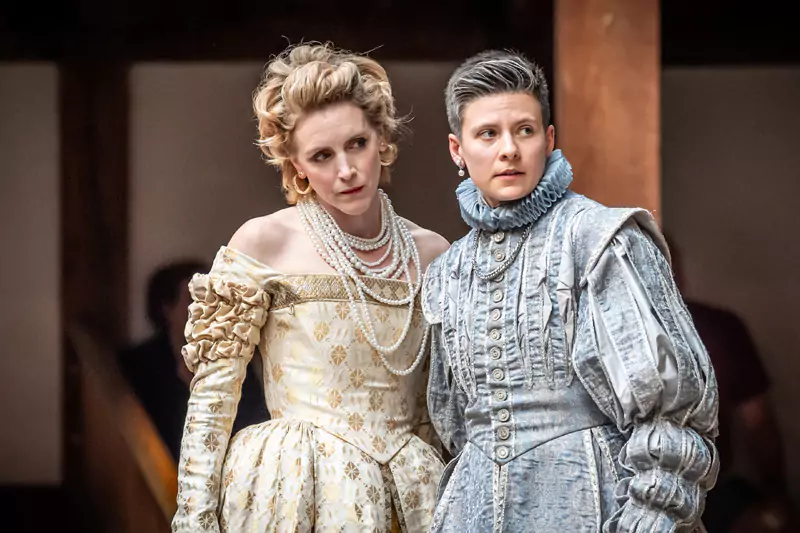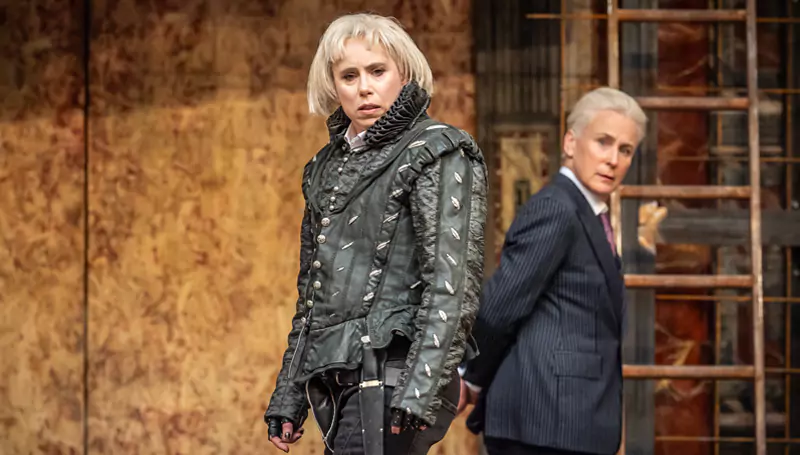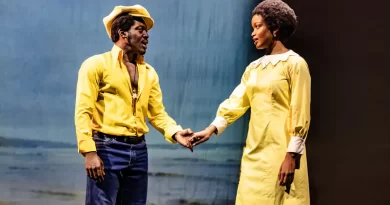“Richard III” at the Globe Theatre
Neil Dowden on the South Bank
29 May 2024
Richard III is, of course, one of Shakespeare’s most villainous characters – he is also disabled. When its summer season was announced, Shakespeare’s Globe was embroiled in a controversy for not giving a disabled actor the opportunity of playing the role, which – gender-swapped – is performed by its artistic director Michelle Terry.

Marianne Oldham and Em Thane.
Photo credit: Marc Brenner.
Casting can be a complex issue – in fact a minefield; does an actor’s specific disability have to match that of their character, and surely no one would now advocate for just non-disabled actors in non-disabled roles? – with colour- and even to a lesser extent gender-blind casts becoming the norm. But it may well be that the Globe has attracted criticism that other recent productions of Richard III with similar lead casting have not because it has been so upfront on its policies of diversity, equality, and inclusion.
Elle While’s production has clearly evolved in response to this controversy because Shakespeare’s text has been edited to remove almost all references to Richard’s disability or deformity – so in a sense offsetting the casting objections. But in doing so it has thrown the baby out with the bathwater.
No doubt the intention is to remove the connection between disability and villainy – and of course the play’s exaggerated representation of Richard’s depravity and real-life scoliosis as “hunchbacked” was part of Tudor propaganda. But this takes out Richard’s bitterness and self-loathing – much of it in response to how people regard his disability, not the disability itself – that drive him to prove himself superior to others by murdering his way to the throne. Now he is just a psychopath.
In fact, the main focus of While’s female-led production is on examining toxic masculinity in relation to power. Again a casting question arises, this time as to whether aggressive misogyny is best depicted on stage without any cis male actors (with the cast including non-binary as well as female actors).
Most notoriously male predation is shown in Richard’s “wooing” of Lady Anne over the corpse of her father-in-law Henry VI who he has murdered (as well as her husband, Edward Prince of Wales). Here, the scene is very much one of force rather than seduction, as Anne is clearly petrified into giving her assent to marriage. And after Richard has casually disposed of his new wife by giving her poisoned wine, he intimidates Queen Elizabeth (widow of his brother, Edward IV) into giving permission for the hand of her young daughter, having already killed three of her sons and a brother.

Michelle Terry as Richard.
Photo credit: Marc Brenner.
It is the female characters in the play who recognize and call out Richard’s crimes on a human level, while the men engage in political struggle. All have been bereaved of husbands, sons, brothers, giving their grief full voice. The scene where three women – Elizabeth, Queen Margaret (Henry VI’s widow), and the Duchess of York (Richard’s own mother) – collectively curse Richard is emotionally powerful. It’s not clear though that misogyny is a dominant theme in this play in which most of Richard’s destructive macho behaviour is meted out on other men.
The play – Shakespeare’s second longest – has been heavily cut to two and a half hours (including interval), with even famous speeches such as Richard’s desperate Bosworth battlefield cry “A horse, a horse, my kingdom for a horse!” axed. Instead, some new text has been added –rather gratuitously – to bolster the production’s concept, especially contemporary references to Donald Trump (including Richard quoting the recording of his infamous “When you’re a star, they let you do it” justification of sexual assault) and Andrew Tate.
Moreover, a short wordless prologue has been inserted at the start of the show which mimes the civil strife of the Wars of the Roses that is the historical background to the play. We see Richard stab Henry VI in the back on the balcony, grab his crown which he gazes at longingly, then descend to the stage to put it on his oldest brother Edward’s head – an effective way to indicate to us that the ruthless Richard is already in control with his sights on becoming king himself.
When Richard’s first speech from the beginning of the play is finally uttered – “Now is the winter of our discontent / Made glorious summer by this son of York” – the first half is spoken to the court rather than as soliloquy, losing some of its biting irony and not straightaway establishing a rapport between Richard and the audience. In the second half, the court freeze as Richard tries to engage our conspiratorial support directly.
It is clear that Richard runs rings around everyone else and will stop at nothing to get what he wants. The murders are executed with horrible vividness. Wrongly imprisoned for treason in the Tower, Richard’s naive brother Clarence is knifed then drowned in a butt, before finally expiring prostate on the stage. Also in the Tower, the two innocent boy princes are dispatched with efficiency by being smothered together in their sleeping bag. Lady Anne collapses onto the stage foaming at the mouth. Each time someone is killed, a trap door opens to receive the corpse in a seemingly endless body count.
Good use is made of the Globe’s stage and auditorium, including audience involvement. When Richard is high above on the balcony pretending that he does not want to be made king, his henchmen whip up the groundlings – with some success! – to plead with him to change his mind. When Henry Richmond (future Henry VII) lands in Britain to fight Richard he makes a rallying call from a small platform in the yard.
But the ending is underwhelming. On the eve of the climactic battle of Bosworth, the ghostly parade of Richard’s cursing victims that disturb his sleep make little impact because he is shown unconscious face down rather than being confronted with his guilty past, while they do not utter blessings to Richmond who is sleeping soundly on the other side of the stage. The battle itself is given short shrift, with Richard’s grinning demise somewhat precipitate.
While’s production is full of ideas, some of which work better than others. The staging is dynamic and the black comedy of the play comes across strongly, though the show is not subtle and sometimes veers towards pantomime. E. M. Parry’s set design has the stage pillars enclosed in wire mesh, doorways boarded up, and ladders extending up to the balcony with a chained-off lopsided platform jutting out dangerously, while the main door’s royal emblems are later replaced by graffiti, suggesting a country in turmoil. The costume designs are a mixture of period and contemporary, with Richard’s followers wearing red baseball caps. James Maloney’s terrific, brassy score is performed by a five-piece band, including snarling saxophones and martial drumbeats.
Terry gives a provocative, in-yer-face performance in the title role, with no suggestion of physical disability in line with the edited text. Full of punkish energy and sardonic humour, this is a Jokerish persona veering towards the cartoonish that is attention grabbing without revealing much inner depth. Wearing a blonde wig, codpiece, and later a prosthetic male torso, her mainly black clothing becomes more colourful as Richard’s plots flourish.
Marianne Oldham is a dignified Elizabeth struggling with the destruction of her family, Katie Erich is the grieving Anne coerced into submission, Poppy Miller plays the vengeful Margaret whose warnings about Richard are not heeded, and Joanne Howarth stands in for Hayley Carmichael as the Duchess of York who knows only too well what her youngest son is capable of. Helen Schlesinger’s besuited fixer Buckingham eventually reaps his reward for his collaboration with Richard, while Sam Crerar is Richard’s nemesis Richmond who brings England’s civil wars to an end.









